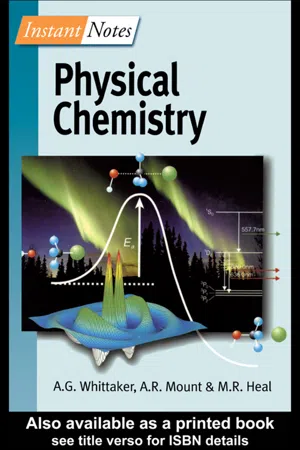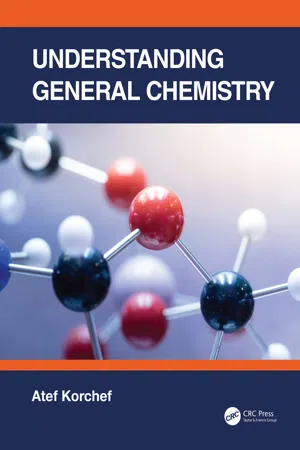Chemistry
Enthalpy for Phase Changes
Enthalpy for phase changes refers to the heat energy absorbed or released when a substance changes from one phase to another, such as from solid to liquid or liquid to gas. This energy is known as the heat of fusion or vaporization and is represented by the enthalpy change (∆H) for the specific phase transition. It is a key concept in understanding the thermodynamics of phase changes.
Written by Perlego with AI-assistance
8 Key excerpts on "Enthalpy for Phase Changes"
Learn about this page
Index pages curate the most relevant extracts from our library of academic textbooks. They’ve been created using an in-house natural language model (NLM), each adding context and meaning to key research topics.
- eBook - ePub
- Gavin Whittaker, Andy Mount, Matthew Heal(Authors)
- 2000(Publication Date)
- Taylor & Francis(Publisher)
n is the molar change in gaseous component. Properties of EnthalphyEnthalpy is a state function whose absolute value cannot be known.ΔH can be ascertained, either by direct methods, where feasible, or indirectly. An increase in the enthalpy of a system, for which ΔH is positive, is referred to as an endothermic process. Conversely, loss of heat from a system, for which ΔH has a negative value, is referred to as an exothermic process. The enthalpy change arising from a temperature change at constant pressure is given by the expression ΔH =C p ΔT , providing that C p does not appreciably change over the temperature range of interest. Where Cp does change, the integral form of the equation , is used. In a chemical reaction, the enthalpy change is equal to the difference in enthalpy between the reactants and products: Kirchhoff’s lawThe value of ΔH for a reaction varies considerably with temperature. Kirchhoff’s s equation, derived from the properties of enthalpy, quantifies this variation. Where C p does not appreciably change over the temperature range of interest, it may be expressed in the form ΔH T2 -ΔH T1 =ΔC p ΔT , or as , where ΔC p is a function of temperature. Related topicsThe first law (B1 )Entropy and change (B5 ) Thermochemistry (B3 )Free energy (B6 ) Entropy ()Statistical thermodynamics (G8 )Enthalpy
The majority of chemical reactions, and almost all biochemical processes in vivo , are performed under constant pressure conditions and involve small volume changes. When a process takes place under constant pressure, and assuming that no work other than pV - eBook - ePub
- Jeffrey Gaffney, Nancy Marley(Authors)
- 2017(Publication Date)
- Elsevier(Publisher)
Fig. 8.3 represents the relative amount of heat required for each phase transition. The phase transitions with arrows pointing up require heat input and are endothermic processes. The phase transitions with arrows pointing down release heat and are exothermic processes.Fig. 8.3 The relationships between changes in enthalpy for different phase transitions. The length of the arrows represents the relative amount of heat required for each phase transition. Transitions with arrows pointing up are endothermic. Transitions with arrows pointing down are exothermic.As shown in Fig. 8.3 , the change in enthalpy for any phase transition is equal but opposite in sign of the reverse transition (e.g., Δ H vap = −Δ H cnd ). Also, the enthalpy changes for linked transitions must balance. For example, when going from the solid to the gas phase, the enthalpy change of the one step process (sublimation) must be equal to the sum of the enthalpy changes of the two step processes (fusion and vaporization).ΔH fus+ ΔH vap= ΔH subΔH frz+ ΔH cnd= ΔH depOne important case for enthalpy changes associated with phase transitions is that for water. Changes in the phases of water are well-studied and have many uses ranging from refrigeration and cooking to steam engines. The changes in temperature of water as heat is added and it going through the phase changes of ice to liquid water and liquid water to steam are shown in Fig. 8.4 . The amount of heat required for the ice to reach the melting point is determined from the specific heat capacity of ice at constant pressure (C p ) and Eq. (11) as; q = m × C p × ΔT - eBook - ePub
- Atef Korchef(Author)
- 2022(Publication Date)
- CRC Press(Publisher)
Figure 5.9 ) and energy is used to overcome attractive forces between molecules.- 14. For a chemical reaction, when
the reaction is exothermic, whenΔH< 0rxnthe reaction is endothermic and whenΔH> 0rxnthe reaction is athermic (no heat is gained or lost).ΔH= 0rxn- 15. The standard enthalpy of formation, designated by
, is the change in enthalpy when one mole of a substance is formed under standard conditions (P = 1 atm and T = 25°C) from its pure elements under the same standard conditions. Conventionally, the standard enthalpy of formation of a pure element in its most stable form is zero.ΔH f °- 16. Bond breaking requires energy. The energy required to break one mole of that chemical bond is called the bond enthalpy or bond dissociation enthalpy. It is also a measure of the bond strength. Bond enthalpy values are always positive since bond breaking is an endothermic process. However, bond making is an exothermic process (it releases energy). Note that a chemical reaction can be described as the breaking of bonds in the reactants and the making of bonds in the products. Thus, if the bond enthalpies of the reactants and products are known, we can calculate the standard enthalpy of the reaction,
:ΔHrxn°ΔH= ∑ Δ Hrxn°− ∑ Δ Hbroken bondsformed bonds- 17. Hess’s law states that, if a chemical reaction is carried out in a series of steps, the enthalpy change ΔH for the overall reaction is equal to the sum of the enthalpy changes for the individual steps. Hess’s law is used to determine the enthalpy of chemical reactions and it can be applied using the Born–Haber cycle to determine the lattice energy for ionic compounds.
- eBook - ePub
- Adrian Dingle, Derrick C. Wood(Authors)
- 2014(Publication Date)
- Research & Education Association(Publisher)
T is the temperature change.vii. A plateau region represents a stage where two phases are in equilibrium with one another.Where the gas is condensing, the amount of energy that is removed can be calculated using q = (ΔHvaporization )(moles).Where the liquid is freezing, the amount of energy that is removed can be calculated using q = (ΔHfusion )(moles).These are exothermic processes because energy must be removed.
A. Calorimetry is an experimental technique used to measure the change in energy of a chemical reaction or phase change.III. Calorimetry1. General principles: Put a chemical reaction or phase change in contact with a heat bath (usually water). We can measure the change in temperature of the heat bath. Knowing the heat capacity of the heat bath, we can calculate the energy change in the heat bath by applying:The energy change in the heat bath will be the same magnitude in energy as the chemical reaction or phase change, just with the opposite sign. If the heat bath gains energy, its temperature goes up, meaning the energy of the chemical reaction or phase change went down (it lost energy) and vice versa.
2. Coffee cup calorimeter—Styrofoam cups are commonly used as insulators in the high school chemistry lab, to measure temperature changes without a loss of energy to the surroundings.Enthalpy changes where energy is released are exothermic and have negative values. Enthalpy changes where energy is absorbed are end othermic and have positive values.Practice Question
1. If 5.00 g of urea are added to 90.00 g of water in a coffee cup calorimeter, the temperature of the contents of the cup falls by 3.100 o C. If the specific heat capacity of the solution is 4.184 J/go - Kevin Reel, Derrick C. Wood, Scott A. Best(Authors)
- 2014(Publication Date)
- Research & Education Association(Publisher)
Chapter 10 Thermochemistry Energy Thermochemistry gives consideration to the fact that energy changes occur during chemical reactions. Energy (E) is defined as the ability do work (w) on a system. From a chemistry perspective, kinetic energy comes in the form of translational, vibrational, and rotational motion of molecules, whereas potential energy arises from chemical bonds and electrostatic interactions. Energy cannot be measured directly and is monitored through changes (ΔE). First Law of Thermodynamics The first law of thermodynamics is commonly called the law of conservation of energy: “energy cannot be created or destroyed.” Energy can only be converted from one form into another during chemical reactions, and therefore the energy of the universe is constant. Energy transfers occur between the system (the reaction we are studying) and the surroundings (everything else in the universe). Heat, Temperature, and Enthalpy In the realm of thermochemistry, there are three frequently used terms that are distinctly different from one another: temperature, heat, and enthalpy. Temperature (T) is a measure of the average kinetic energy of molecules, which means that at higher temperatures molecules are moving faster. On the other hand, heat (q) measures the total kinetic energy of all of the particles in a sample. We use temperature as a means to monitor heat transfers. Heat transfers are kinetic energy transfers that go from a hotter object to a cooler object until both objects are at the same temperature. According to the first law of thermodynamics, heat lost by a hotter object is gained by a colder object. In contrast, enthalpy (H) refers to the energy released or absorbed by a chemical reaction. Unless there is pressure–volume (PΔV) work performed by the system, changes in enthalpy (ΔH) are essentially the same as the heat exchanged during a reaction- eBook - ePub
- Warren C. Strahle, William A. Sirignano, William A. Sirignano(Authors)
- 2020(Publication Date)
- Routledge(Publisher)
2 CHEMICAL THERMODYNAMICS2.1 INTRODUCTION
Thermodynamics is an empirical science dealing with the properties of substances and their energetics. It applies to systems of a single phase and multiple phases. For purposes here it also applies to systems of varying chemical composition. The subject of chemical thermodynamics applies to fixed mass and flowing systems, just as in the case of fixed composition systems. The subject simply becomes a bit more complex when chemical change is involved, than in the case of fixed composition systems. Since combustion involves composition changes, however, this complexity must be accepted as necessary.Thermodynamics enables us to calculate the energetics of system changes in composition. As such it enables us to determine, for example, the temperature and pressure changes when a system undergoes a chemical transformation. It will be seen that thermodynamics can also be used to tell us what the composition change will be when a system undergoes a reaction. It is not used, however, to determine rates of chemical transition. That is the subject of a following chapter on chemical kinetics. The subject of thermodynamics is only concerned with beginning and end thermodynamic states for a system, with no concern for the process path between them. Nevertheless, it is an essential science in combustion.2.2 PROPERTIES OF SUBSTANCES
We shall deal with solids, liquids and gases. For solids and liquids we will use the actual measured thermodynamic properties of the substances. So, for example, any thermodynamic equation of state such as a relation between pressure, temperature and volume for liquids and solids will be the actual measured relation. For gases, however, but with good approximation, we will always assume them to be thermally perfect gases. The term “thermally perfect” means that the gas obeys the equation of state(2.1)where V is a fixed system volume, ρ is pressure and T is absolute thermodynamic temperature. The symbol n - eBook - ePub
Biomolecular Thermodynamics
From Theory to Application
- Douglas Barrick(Author)
- 2017(Publication Date)
- CRC Press(Publisher)
§ Interpreted structurally, heat put into the system under conditions of phase coexistence simply shifts material from the low enthalpy phase to the high enthalpy phase, breaking lattice or liquid bonds (for solid and liquid, respectively), without changing the temperature.Passage contains an image Adding the effects of pressure to chemical potential relationships
So far we have examined the effects of temperature on phase equilibrium at constant pressure. What about the effects of pressure on phase equilibrium? The effects of pressure result from theterm in the differential expression for molar free energy variation:d pV ¯πd= dG ¯πμ π= −d T +S ¯πd pV ¯π(6.25) (see Chapter 5 ; a formal derivation for molar quantities is given below, Equations 6.32 through 6.37 ). For phases with large molar volumes, chemical potential will vary strongly with pressure. At moderate pressures, the volume of the gas phase is typically much larger than the volumes of the condensed phases. For example, for water at the boiling point at 1 atm of pressure, one mole of water vapor occupies about 30 liters, whereas ice and liquid water occupy 0.0186 and 0.0187 liters, respectively; that is, the gas phase has more than 1000 times greater molar volume than the condensed phases. Moreover, the compressibility and the thermal expansivity coefficients (κ T and α - eBook - ePub
- Kevin R. Reel(Author)
- 2013(Publication Date)
- Research & Education Association(Publisher)
1. Gases are at 1 atmosphere pressure. 2. Liquids and solids are pure. 3. Solutions are at 1molar concentration. 4. The temperature is 25° C, or 298 K. • Do not confuse thermodynamic standard conditions, where the temperature is 298 K, with standard temperature and pressure (STP) for gases, where the temperature is 273 K.FIRST LAW AND ENTHALPY
First Law of Thermodynamics
• The first law of thermodynamics is commonly referred to as the law of Conservation of Energy.• More specifically, the first law states that the change in internal energy is equal to the difference between the energy supplied to the system as heat and the energy removed from the system as work performed on the surroundings.Example: An ideal gas absorbs 100 L atm of heat energy, which expands against a pressure of 8.0 atm. The total energy of the system is −20.0 L atm. How much does the volume change during the expansion? Solution:Enthalpy
• Enthalpy is a state function.• The enthalpy change in a reaction (ΔH) is the difference between the enthalpy contained in the products and the enthalpy contained in the reactants.• Exothermic reactions give off heat energy, ΔHreaction < 0. The products of the reaction have less enthalpy than the reactants.• Endothermic reactions take in heat energy, ΔHreaction > 0. The products of the reaction have more enthalpy than the reactants.Heats of Formation, Heats of Reaction
• The standard heat of formation (ΔH°f) is the change of enthalpy for the reaction that forms a compound from its pure elements under standard conditions.• The standard heat of formation (ΔH°• Standard heats of formation can be used to estimate the ΔH° of any reaction Example: Calculate ΔH° for the reaction,f) for a pure element at standard conditions is zero.PbO2 (s) + 2H2 SO4 (l) + Pb(s) → 2PbSO4 (s) + 2H2 O(l)given the following ΔH°f information.
Solution:Species ΔH°f(KJ)Pbo2 (s )−66.3 H2 so4 (l )−194.5 Pbso4 (s )−219.9 h2 o(l )−68.3 Δ H°reaction







